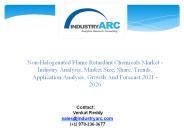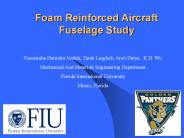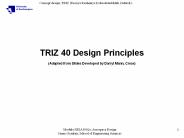Aerospace Foam Analysis PowerPoint PPT Presentations
All Time
Recommended
Aerospace foam market garnered a revenue of USD 4.32 billion in the year 2019 globally and has been foreseen to yield USD 7.11 billion by the year 2027 at a compound annual growth (CAGR) of 8.0% over the forecast period.
| PowerPoint PPT presentation | free to download
According to Precision Business Insights, The size analysis of the aerospace foams market is expected to reach a value of USD 9.6 billion from 2023-29
| PowerPoint PPT presentation | free to download
Adroit Market Research, recently published a detailed market research study focused on the “Aerospace Foams Material Market” across the global, regional and country level.
| PowerPoint PPT presentation | free to download
According to the latest research report by IMARC Group, The global aerospace foam market size reached US$ 5.6 Billion in 2023. Looking forward, IMARC Group expects the market to reach US$ 9.2 Billion by 2032, exhibiting a growth rate (CAGR) of 5.6% during 2024-2032. More Info:- https://www.imarcgroup.com/aerospace-foam-market
| PowerPoint PPT presentation | free to download
The market is primarily driven by the rising volume of air traffic and the escalating demand for fuel-efficient and lightweight aircraft worldwide. In addition, the increasing government investments in military aircraft and renewable feedstock for manufacturing green aerospace foams represent another major growth-inducing factor. Know More: https://www.imarcgroup.com/aerospace-foam-market
| PowerPoint PPT presentation | free to download
According to the latest research report by IMARC Group, The global flexible foam market size reached US$ 45.6 Billion in 2022. Looking forward, IMARC Group expects the market to reach US$ 61.4 Billion by 2028, exhibiting a growth rate (CAGR) of 4.9% during 2023-2028. More Info:- https://www.imarcgroup.com/flexible-foam-market
| PowerPoint PPT presentation | free to download
TBRC aerospace foams market report includes aircraft seats, aircraft floor carpets, cabin walls and ceilings, flight deck pads, overhead stow bins, others
| PowerPoint PPT presentation | free to download
Avail more information from Sample Brochure of report @ https://goo.gl/7oO6ZB A detailed qualitative analysis of the factors responsible for driving and restraining growth of the Global Aerospace Foam Market 2016-2020 Industry Market and future opportunities are provided in the report.
| PowerPoint PPT presentation | free to download
Aerospace insulation refers to the material installed in the aircraft to improve safety and comfort levels. Functions of the aircraft in severe climatic conditions should adhere to certain fundamental operations as well as safety measures concerning both weight and temperature terms and overall performance. Due to advantages, such as lower vibration and noise levels during flying hours, the demand for insulating materials is growing at a rapid pace. The rising usage of composites in commercial aircraft is expected to push the development of diverse aerostructures, resulting in substantial industry potential. The increasing demand for lightweight insulating materials and composite materials in the commercial aircraft and business jet industries to reduce cabin noise is likely to drive the market over the next few years.
| PowerPoint PPT presentation | free to download
Aerospace foam: A projected value of $5,246.44 Million by 2020, signifying firm annualized growth of 7.74% between 2015 and 2020. The major players of the aerospace foam market include BASF SE (Germany), Evonik Industries (Germany), SABIC Innovative Plastics (Saudi Arabia), Rogers Corporation (U.S.), Zotefoams Plc (U.K.), UFP Technologies (U.S.), ERG Aerospace (U.S.), Boyd Corporation (U.S.) Roger Corporation (U.S.), Armacell International SA (U.S.), and Benien Aerospace (Germany).
| PowerPoint PPT presentation | free to download
The aerospace foam market has witnessed a significant growth in the recent years, and this growth is projected to persist in the coming years. Aerospace foams due to their characteristic properties provide sound barrier, shock absorption, and sound attenuation. Owing to these properties, aerospace foams are widely used in aerospace applications.
| PowerPoint PPT presentation | free to download
Aerospace tapes refer to tapes used to create optimal surfaces to protect the aircraft composite molding. The aerospace tape is used for bonding, insulation, and sealing of aircraft's sensitive equipment and aircraft structures. These increase the lifespan of an aircraft's infrastructure and equipment and reduce the maintenance cost by protecting against vibrations, corrosion, and fluids.
| PowerPoint PPT presentation | free to download
This study estimates the global market of aerospace foam by the end of 2020. This market research study provides detailed qualitative and quantitative analyses of the global aerospace foam market. It also provides a comprehensive review of major market drivers, restraints, opportunities, winning imperatives, challenges, and key issues in the market. The market is further segmented and forecast for major geographic regions, North America, Europe, Asia Pacific, and Rest of the World. Major countries with the market size in terms of volumes and values are covered for each of the region.
| PowerPoint PPT presentation | free to download
More Information @ http://bit.ly/2Fl5uje Aerospace Foam industry is segmented based on materials into polyurethane, metal, polyethylene, and melamine foams.
| PowerPoint PPT presentation | free to download
Get a sample brochure @ http://tinyurl.com/j8tl662 Aerospace foams are manufactured using various materials such as polyurethane (PU) foams, polyethylene (PE) foams, metal foams, melamine foams, and other types of foams, including polyvinylidene fluoride (PVDF), polyphenylsulfone (PPSU), silicones, polyetherimide (PEI), and polymethacrylimide (PMI). These foams are used in various applications such as seating, gaskets, seals, carpet pads, rotor blades, headrest, doors, windshields, cockpit instrument panel, and wingtip lens. The aerospace foam market is segmented in different end-use industries, which include commercial aircraft, general aviation, and military aircraft.
| PowerPoint PPT presentation | free to download
Aerospace Foams Market by Type (Polyurethane foam, Polyethylene foam, Fluoropolymer foam, Metal foam), Aerospace foams Market by End-User Industry (General Aviation, Commercial Aircraft, Military Aircraft) and by Region - Trends and Forecasts to 2019
| PowerPoint PPT presentation | free to download
Get your sample copy of PMI Foam Market and Other High Performance Foam Core Market @ http://www.rnrmarketresearch.com/contacts/request-sample?rname=544013 . This high growth is attributed to increasing use of HPFC in the aerospace & defense application. HPFC provides additional strength and heat resistance to the components even at low densities.
| PowerPoint PPT presentation | free to download
Aerospace foam market is expected to reach USD 9.81 billion by 2027 growing at a growth rate of 6.20% in the forecast period 2020 to 2027. Global aerospace foam market report analyses the growth of this specific market which has been directly related to the increased volume of air traffic and airways travelling population considering the growth of disposable income worldwide.
| PowerPoint PPT presentation | free to view
As per Global Market Insights, Inc. estimates, the global metal foam market size is expected to surpass $96.5 million by 2027
| PowerPoint PPT presentation | free to download
The Fire Protection Materials market size is estimated to reach US$4.3 billion by 2027 after growing at a CAGR of 8.8% during the forecast period 2022-2027.
| PowerPoint PPT presentation | free to download
The objective of the report is to estimate the size of the aerospace foams market and the future growth potential of the types of aerospace foams market across different segments, such as type and end-use industry etc.
| PowerPoint PPT presentation | free to download
The accelerating market for foam tape for consumption of PU foam as a solution is one of the vital circumstances anticipated to propel the requirement for bonding and sealing applications in the market. Some of the other factors driving the market growth are increasing demand for polyethylene foam as a solvent in end-user automotive industry and furniture manufacturing
| PowerPoint PPT presentation | free to download
Global Metal Foam Market Research Report — by Material (Aluminum, Copper, Nickel, Zinc), Product (Closed Cell Metal Foam), Application (Heat Exchangers, Energy Absorbers), End-use Industry (Automotive, Bio-Medical, Marine), and Region—Forecast to 2023
| PowerPoint PPT presentation | free to download
Global Elastomeric Foam Market: Information by Type (Natural Rubber and Synthetic Rubber), End-Use Industry (HVAC, Automotive, Electrical and Electronics, and Others), and Region (Asia-Pacific, North America, Europe, and Others)—Forecast till 2023
| PowerPoint PPT presentation | free to download
Non-Halogenated Flame Retardant Chemicals Market size is forecast to reach $2.18 billion by 2025, after growing at a CAGR of 6.2% during 2020-2025. The Non-Halogenated Flame Retardant Chemicals market is driven by increasing consumer demand for electrical & electronic products across the world.
| PowerPoint PPT presentation | free to download
Electrostatic discharge foam is very lightweight plastics that are gravely important in a wide range of end-use applications. It is used in the shock absorption and recovers its shape quickly. Electrostatic discharge (ESD) materials are plastics with lessen static electricity to protect electrostatic-sensitive devices
| PowerPoint PPT presentation | free to download
The research report has incorporated the analysis of different factors that augment the market’s growth.
| PowerPoint PPT presentation | free to download
Aerospace foam is a type of high performing insulating material designed to provide cushioning, support and structural support to the applicable areas they are used for. These materials provide protection against unwanted vibrations, enhance the insulation and improve the comfort levels by elevating the levels of cushioning.
| PowerPoint PPT presentation | free to download
Growing government initiatives in developed as well as developing economies to reduce overall weight of the aircraft, increasing need for fuel efficient aircrafts, and increasing need for aircraft modernization are factors fueling the global aerospace tapes industry growth.
| PowerPoint PPT presentation | free to download
Aerospace Insulation Market Forecast to 2028 - COVID-19 Impact and Global Analysis By Product (Thermal Insulation, Acoustic Insulation, Electric Insulation, and Vibration Insulation), Insulation Material (Mineral Wool, Ceramic-based Materials, Foamed Plastics, and Fiberglass & Others), Aircraft Type (Commercial Aircraft, Military Aircraft, and Helicopters), and Application (Engine and Airframe)
| PowerPoint PPT presentation | free to download
Thermal Insulation Market Forecast to 2028 - COVID-19 Impact and Global Analysis By Material Type (Fiber Glass, Plastic Foam, Stone Wool, Calcium Silicate, Cellular Glass, and Others) and Industry Vertical (Building and Construction, Oil and Gas, Chemical, Aerospace and Defense, Automotive, Pharmaceutical, and Others)
| PowerPoint PPT presentation | free to download
The Silicone Foam market size is estimated to increase by USD 25 Billion at a CAGR of 8.1% from 2023 to 2028. The report includes historic market data from 2017 to 2022E. Currently, market value is pegged at USD 93.9 Billion. Get Detailed TOC and Overview of Report @ https://www.htfmarketintelligence.com/report/global-silicone-foam-market
| PowerPoint PPT presentation | free to download
Aerospace Education & Research in the Area of Design Diamond Jubilee Lectures 2003-04 Department of Aerospace Engineering Indian Institute of Science, Bangalore
| PowerPoint PPT presentation | free to download
The global foam tape market was valued at USD 7.52 billion in 2018 and is expected to reach USD 12.81 billion by 2026, with an anticipated CAGR of 6.89% during the forecast period, 2019–2026.
| PowerPoint PPT presentation | free to download
Structures and Weights Preliminary Design Review Phoenix Aerospace Structures Team Jamie Allen Andy Wiratama Objectives Material Properties V-n Diagram Wing ...
| PowerPoint PPT presentation | free to download
Courses of study. System Modeling & Simulation$ Optimization ... Unsteady aerodynamics for prescribed motion. Aero elastic analysis for prescribed actuation ...
| PowerPoint PPT presentation | free to view
High Heat Foam Market by Type (Silicone, Polyimide, Melamine, Polyethylene, & Others), by Application (Automotive, Railway, Industrial, Aerospace & Others) - Global Forecasts to 2021
| PowerPoint PPT presentation | free to download
Get your sample copy of Engineered Foam Market Research Report at https://goo.gl/3SzpUA Aerospace & defense, followed by the medical & healthcare segment dominated the global engineered foam market in 2015
| PowerPoint PPT presentation | free to download
The report "Microcellular Polyurethane Foam Market by Type (Low Density Foam, High Density Foam), Application (Automotive, Building & Construction, Electronics, Medical, Aerospace, Others), Region (North America, Europe, APAC, MEA, RoW) - Global Forecast to 2021", is projected to reach USD 6.95 Billion by 2021 growing at a CAGR of 5.5% due to the increasing demand of light-weight materials by the various end-use industries, major ones being automotive, building & construction, electronics, and aerospace.
| PowerPoint PPT presentation | free to download
According to the latest research report by IMARC Group, The global polyols market size reached US$ 27.9 Billion in 2023. Looking forward, IMARC Group expects the market to reach US$ 45.9 Billion by 2032, exhibiting a growth rate (CAGR) of 5.5% during 2024-2032. More Info:- https://www.imarcgroup.com/polyols-market
| PowerPoint PPT presentation | free to download
High Heat Foam Market Size, Industry Analysis Report, Regional Outlook (U.S., Germany, UK, Italy, Russia, China, India, Japan, South Korea, Brazil, Mexico, Saudi Arabia, UAE, South Africa), Application Development Potential, Price Trend, Competitive Market Share & Forecast, 2017 – 2024
| PowerPoint PPT presentation | free to download
Foam Reinforced Aircraft Fuselage Study Narasimha Harindra Vedala, Tarek Lazghab, Amit Datye, K.H. Wu Mechanical And Materials Engineering Department
| PowerPoint PPT presentation | free to download
According to the latest research report by IMARC Group, The global flexible foam market size reached US$ 47.8 Billion in 2023. Looking forward, IMARC Group expects the market to reach US$ 70.8 Billion by 2032, exhibiting a growth rate (CAGR) of 4.36% during 2024-2032. More Info:- https://www.imarcgroup.com/flexible-foam-market
| PowerPoint PPT presentation | free to download
PET Foam market is forecast to reach $185.8 million by 2026, after growing at a CAGR of 7.5% during 2021-2026
| PowerPoint PPT presentation | free to download
Acoustic Insulation Market by Type (Stone Wool, Glass Wool, Polystyrene, Foamed Plastic, Aerogel and Cellulose) by End User (Building & Construction, Commercial Building Industry, Residential Building Industry, Transportation, Automotive Industry, Marine Industry, Aerospace Industry) by Region Forecast 2017-2024
| PowerPoint PPT presentation | free to download
Polyethylene Foams market is segmented by Type, and by Application.
| PowerPoint PPT presentation | free to download
Stress Intensity Factors. It is defined a quantity that characterizes ... parametric is developed which can be used for different fuselage configurations ...
| PowerPoint PPT presentation | free to download
... (e.g .Watt governor) Maglev train uses magnetic repulsion to reduce friction Module SESA3002a; Aerospace Design James Scanlan; ...
| PowerPoint PPT presentation | free to download
Global Structural Core Materials Market: Information by Product (Foam, Balsa, and Honeycomb), Skin Type (GFRP, CFRP, and NFRP), End-Use Industry (Aerospace, Automotive, Wind Energy, Marine), and Region—Forecast till 2023
| PowerPoint PPT presentation | free to download
PVC Foam market is segmented by region (country), players, by Type, and by Application. Players, stakeholders, and other participants.
| PowerPoint PPT presentation | free to download
Global Structural Core Materials Market: Information by Product (Foam, Balsa, and Honeycomb), Skin Type (GFRP, CFRP, and NFRP), End-Use Industry (Aerospace, Automotive, Wind Energy, Marine), and Region—Forecast till 2023
| PowerPoint PPT presentation | free to download
Aircraft Seating Market Size, Share and Industry Analysis, By Class (Business, First, Premium Economy, and Economy), Seat Type (9g and 16g), Aircraft Type (Commercial, Business, and Regional Aircraft), Components (Structures, Foams, Actuators, and Electrical Fittings), End-Use (OEMs and Aftermarket), and Regional Forecast, 2018-2026
| PowerPoint PPT presentation | free to download
TBRC global dunnage packaging market report includes dunnage air bags, inserts, dividers, packaging peanuts, other product types, corrugated plastic, molded plastic, foam, steel https://bit.ly/3h4J38Y
| PowerPoint PPT presentation | free to download
Download FREE Research Report Sample PDF: https://bit.ly/30vKDc2 Understanding the segments helps in identifying the importance of different factors that aid the market growth. #MicrocellularPolyurethane #market research report #forecast 2027 #24chemicalresearch
| PowerPoint PPT presentation | free to download
Global Polyetherimide Market: Information by Process (Injection Molding, Blow Molding, Foam Molding and Extrusion), Type (Unreinforced and Reinforced), Form (Sheets, Rods, Granules and Films), End-Use Industry (Automotive, Medical, Food & Beverage, Aerospace, Marine, Telecommunication, Electrical & Electronics and others) and Region (North America, Europe, Latin America, Asia-Pacific and the Middle East & Africa) - Forecast till 2024
| PowerPoint PPT presentation | free to download
The research report includes specific segments by region (country), by manufacturers, by Type and by Application.
| PowerPoint PPT presentation | free to download











![Building Success on: Industrial Aerospace Foam Market Plan [2015 to 2020] PowerPoint PPT Presentation](https://s3.amazonaws.com/images.powershow.com/8854510.th0.jpg)

![Building Success on Industrial Aerospace Foam Market Plan [2015 to 2020] PowerPoint PPT Presentation](https://s3.amazonaws.com/images.powershow.com/8858507.th0.jpg)










































